Reproduction
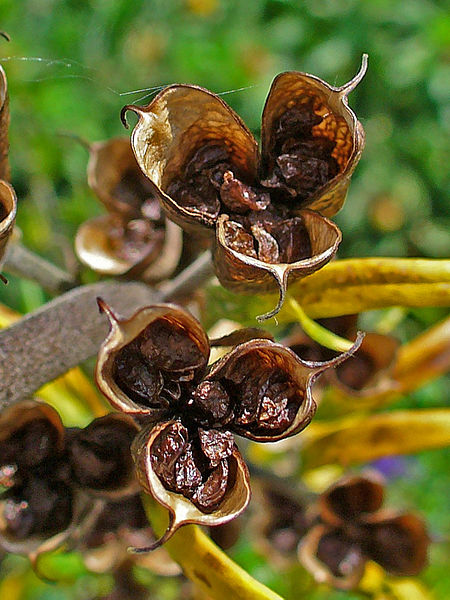 Aconitum napellus reproduces mainly sexually by the process
of double fertilization, but it also has the potential to
reproduce asexually through such means as fragmentation (the
separation of parent plant into parts that develop into their
own whole plants), or apomixes (the creation of seeds without
pollination or fertilization, using a diploid cell from one
parent plant to make an embryo). Double fertilization can happen
either through self-fertilization, the fertilization of the
plant by its own pollen, or cross-fertilization, which is the
fertilization by a different plant’s pollen. Although, some
plants have mechanisms in place that make it harder to for
successful self-fertilization so that cross-fertilization is
favored and there is more genetic recombination within the
species. Fruiting is also an important part of this plant's
reproductive process. Aconitum napellus makes fruit for
increased seed dispersal.
Aconitum napellus reproduces mainly sexually by the process
of double fertilization, but it also has the potential to
reproduce asexually through such means as fragmentation (the
separation of parent plant into parts that develop into their
own whole plants), or apomixes (the creation of seeds without
pollination or fertilization, using a diploid cell from one
parent plant to make an embryo). Double fertilization can happen
either through self-fertilization, the fertilization of the
plant by its own pollen, or cross-fertilization, which is the
fertilization by a different plant’s pollen. Although, some
plants have mechanisms in place that make it harder to for
successful self-fertilization so that cross-fertilization is
favored and there is more genetic recombination within the
species. Fruiting is also an important part of this plant's
reproductive process. Aconitum napellus makes fruit for
increased seed dispersal.
Since double fertilization is the most popular means by which
this plant produces let’s go into more detail on how that
happens. We are going to go through double fertilization in a
step-by-step process, but first let’s review some background
information on the structures that we are going to need to
understand beforehand.
Double fertilization is a form of sexual reproduction that is
exhibited in flowering plants. The nine main structures we are
going to focus in on are these:

1. The pistil: the flower pistil is essentially the girl part of
a flower. It can often be found in the very middle of the
flower, and it consists primarily of a long hollow stalk with
pollen receptors at the end (1A), and an ovule tucked away near
the bottom.
2. The pollen: pollen is for all essential purposes a protective
transportation device for the male gametes of the plant. Pollen
is often dispersed into the air, or carried by various
organisms, known as pollinators, from one flowering plant to the
next.
3. The pollen tube: the pollen tube is what the pollen grows
into once it attaches to one of the pollen receptors of the
pistil. This structure is what eventually brings the sperm
nuclei stored inside the pollen to the egg of the plant where
fertilization occurs.
4. The generative cell: this is the cell that is directly
transported through the pollen tube to the ovule. An important
thing to notice about this is that this cell has TWO sperm
nuclei. This is a fact that will come in later.
5. The egg: this is the female gamete, and it is the middle of
the three cells beneath the center cell.
6. The synergids: these are the two cells on either side of the
cell that will eventually become the embryo. Both of the
synergids actually contain a haploid nucleus inside them, just
like the egg, but they play a very different role in the
reproduction process.
7. The polar nuclei: these two nuclei are important in the
formation of the endosperm, an important part of the seed that
provides nourishment to the plant embryo as it first starts to
grow, and they reside together in one larger cell that is at the
center of the entire structure (central cell).
8. The three antipodial cells: these cells are also haploid
cells, but they sit above the cell with polar nuclei rather than
below it. They
are not extremely important in anything we are going to go over,
but it is still important to recognize that they are there.
9. The ovule: this is the general place where fertilization
occurs. It is essentially a structure incorporating all of
the important reproductive female cells in the flower. This entire structure is what
eventually becomes the seed after double fertilization is
completed.
Now let’s go through a brief step-by-step summary of
double-fertilization and how it works!
Step One: Pollination
The first thing that must happen for double-fertilization to
occur is that pollen must reach the pollen receptors of the
pistil. In Aconitum napellus this generally happens through the
help of a pollinator, the most common of which for this species
of flower is one we are all very familiar with, the common
bumblebee. Below
is a perfect video showing this mutualistic relationship between
the two species. For information on how the flower has adapted
to hold preference toward this particular pollinator click on
the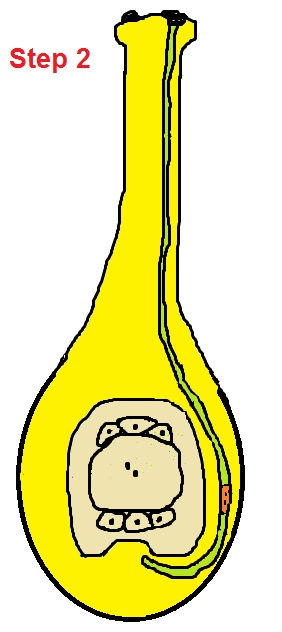 link here.
link here.
Step Two: Growth of the pollen tube
Once the pollen is received at the pollen receptor, it has to
travel the relatively large distance to the actual ovule of the
flower. This is done through the growth of a pollen tube down
the pistil to transport the generative cell with the two vital
sperm nuclei inside it to the egg for fertilization. The sperm
tube can take a couple days to grow, so this is often the
longest part of the fertilization process. The tube grows down
until it is under the ovule as shown in the diagram to the
right.
Step Three: Merging of the sperm cell nuclei with one of the
synergids
Depending on what side of the ovule the sperm tube ended up
growing to, it will eventually penetrate into the bottom of the
ovule and fuse its generative cell with the two sperm nuclei
into either the right or left synergids. The synergid cell is
then temporarily triploid as it has three haploid nuclei in it
at one time. The important thing to recognize is that the nuclei
do not fuse together. Here is a picture of that step below:
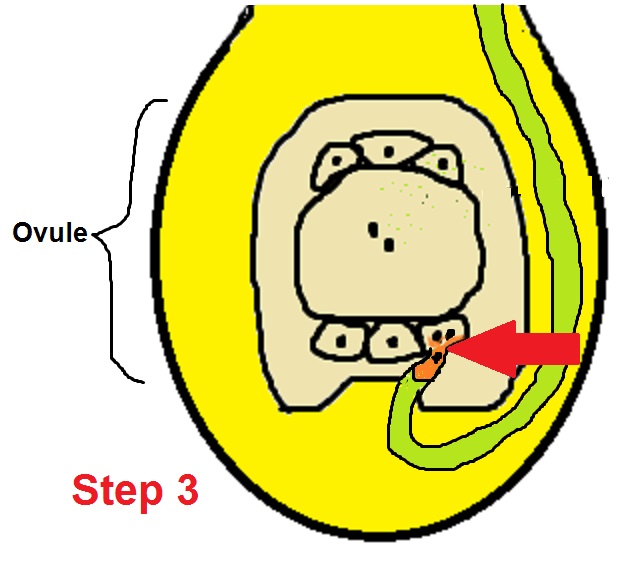
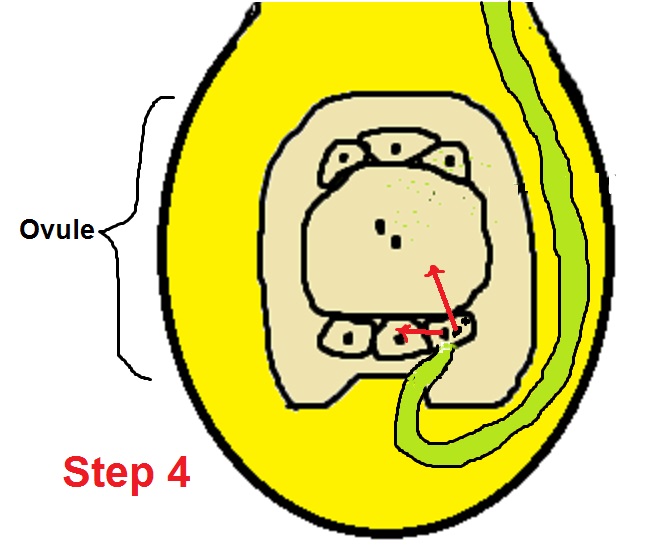
Step Four: Movement of two nuclei: one to the polar body cell,
and one to the ovary
In this step the two extra nuclei that just passed into the
synergid move to different cells. One of the nuclei pass through
the cell into the egg cell, and the other passes up into the
center cell with the two polar nuclei and creates a new triploid
cell (3n). Diagram above.
Step Five: The egg and sperm nuclei fuse
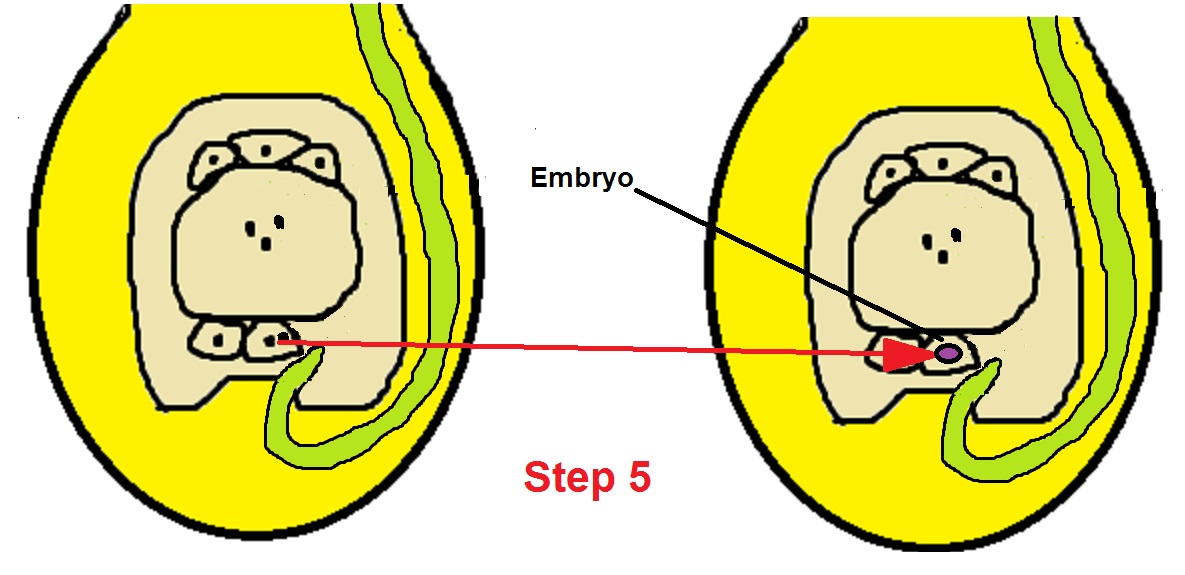
Finally, the two nuclei of the parent plants are able to fuse together,
creating a diploid zygote that will eventually become the new
adult plant. A diagram is above.
Step 6: The formation of the endosperm/seed. As the sperm and
egg are fusing the other parts of the ovule develop into their
own special roles to help make a seed. The triploid cell with
the sperm nucleus and two polar body nuclei is what develops
into the endosperm of the seed. To hear more about the endosperm
click on the link here.
To go back to the home page click here.
